Lock Acura MDX 2009 Owner's Manual
[x] Cancel search | Manufacturer: ACURA, Model Year: 2009, Model line: MDX, Model: Acura MDX 2009Pages: 489, PDF Size: 11.91 MB
Page 7 of 489
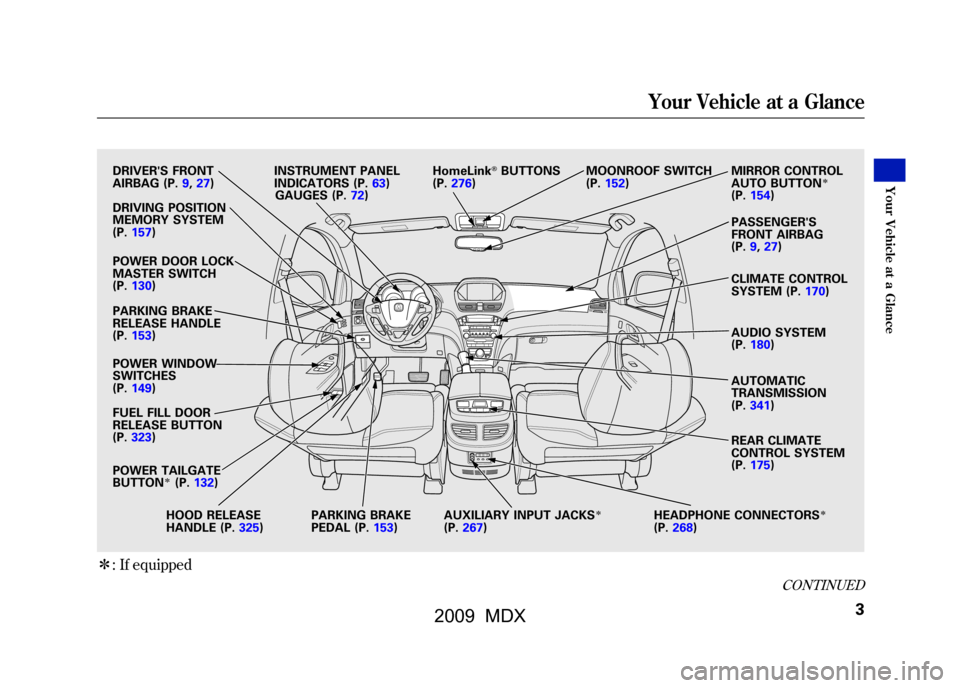
ꭧ: If equipped
DRIVER'S FRONT
AIRBAG (P.9,27)
DRIVING POSITION
MEMORY SYSTEM
(P.157)
POWER DOOR LOCK
MASTER SWITCH
(P.130)
PARKING BRAKE
RELEASE HANDLE
(P.153)
POWER WINDOW
SWITCHES
(P.149)
FUEL FILL DOOR
RELEASE BUTTON
(P.323)
POWER TAILGATE
BUTTON
ꭧ(P. 132)
HOOD RELEASE
HANDLE (P.325) PARKING BRAKE
PEDAL (P.153)AUXILIARY INPUT JACKS
ꭧ
(P.
267) HEADPHONE CONNECTORS
ꭧ
(P.
268)
INSTRUMENT PANEL
INDICATORS (P.63)
HomeLink
®BUTTONS
(P.276) MOONROOF SWITCH
(P.152)MIRROR CONTROL
AUTO BUTTON
ꭧ
(P.
154)
PASSENGER'S
FRONT AIRBAG
(P.9,27)
CLIMATE CONTROL
SYSTEM (P.170)
AUDIO SYSTEM
(P.180)
AUTOMATIC
TRANSMISSION
(P.341)
REAR CLIMATE
CONTROL SYSTEM
(P.175)
GAUGES (P.72)
CONTINUED
Your Vehicle at a Glance
3
Your V ehicle at a Glance
08/06/06 16:58:07 09 ACURA MDX MMC North America Owner's M 50 31STX620 enu
2009 MDX
Page 8 of 489
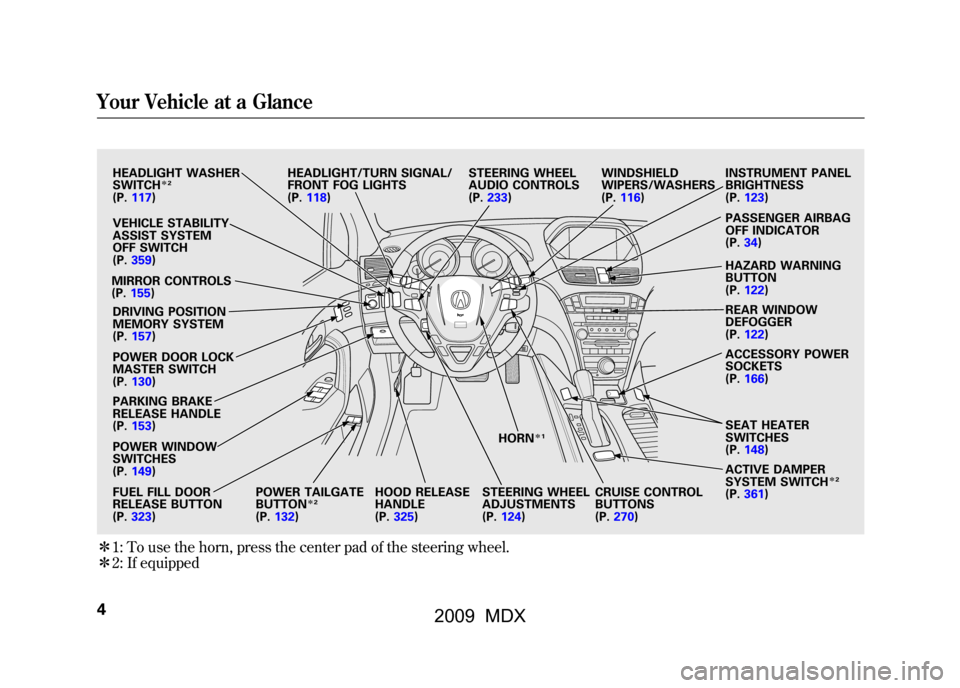
ꭧ1:To use the horn, press the center pad of the steering wheel.
ꭧ 2: If equipped
HEADLIGHT WASHER
SWITCH
ꭧ 2
(P. 117)
VEHICLE STABILITY
ASSIST SYSTEM
OFF SWITCH
(P. 359)
MIRROR CONTROLS
(P. 155)
DRIVING POSITION
MEMORY SYSTEM
(P. 157)
POWER DOOR LOCK
MASTER SWITCH
(P. 130)
PARKING BRAKE
RELEASE HANDLE
(P. 153)
POWER WINDOW
SWITCHES
(P. 149)
FUEL FILL DOOR
RELEASE BUTTON
(P. 323) POWER TAILGATE
BUTTON
ꭧ
2
(P. 132) HOOD RELEASE
HANDLE
(P.
325) HORN
ꭧ
1
STEERING WHEEL
ADJUSTMENTS
(P. 124)
HEADLIGHT/TURN SIGNAL/
FRONT FOG LIGHTS
(P.
118) STEERING WHEEL
AUDIO CONTROLS
(P.
233) WINDSHIELD
WIPERS/WASHERS
(P.
116) INSTRUMENT PANEL
BRIGHTNESS
(P.
123)
PASSENGER AIRBAG
OFF INDICATOR
(P. 34)
HAZARD WARNING
BUTTON
(P. 122)
REAR WINDOW
DEFOGGER
(P. 122)
ACCESSORY POWER
SOCKETS
(P. 166)
SEAT HEATER
SWITCHES
(P. 148)
ACTIVE DAMPER
SYSTEM SWITCH
ꭧ 2
(P. 361)
CRUISE CONTROL
BUTTONS
(P.
270)
Your Vehicle at a Glance408/06/06 16:58:07 09 ACURA MDX MMC North America Owner's M 50 31STX620 enu
2009 MDX
Page 9 of 489
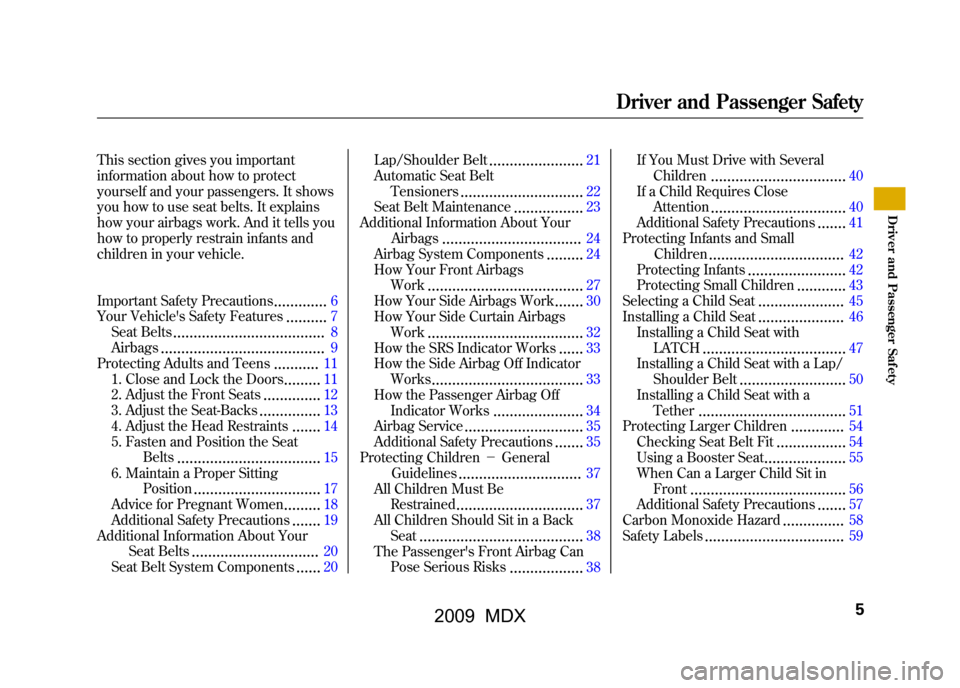
This section gives you important
information about how to protect
yourself and your passengers. It shows
you how to use seat belts. It explains
how your airbags work. And it tells you
how to properly restrain infants and
children in your vehicle.
Important Safety Precautions
.............
6
Your Vehicle's Safety Features
..........
7
Seat Belts
.....................................
8
Airbags
........................................
9
Protecting Adults and Teens
...........
11
1. Close and Lock the Doors
.........
11
2. Adjust the Front Seats
..............
12
3. Adjust the Seat-Backs
...............
13
4. Adjust the Head Restraints
.......
14
5. Fasten and Position the Seat
Belts
...................................
15
6. Maintain a Proper Sitting
Position
...............................
17
Advice for Pregnant Women
.........
18
Additional Safety Precautions
.......
19
Additional Information About Your Seat Belts
...............................
20
Seat Belt System Components
......
20 Lap/Shoulder Belt
.......................
21
Automatic Seat Belt Tensioners
..............................
22
Seat Belt Maintenance
.................
23
Additional Information About Your Airbags
..................................
24
Airbag System Components
.........
24
How Your Front Airbags Work
......................................
27
How Your Side Airbags Work
.......
30
How Your Side Curtain Airbags Work
......................................
32
How the SRS Indicator Works
......
33
How the Side Airbag Off Indicator Works
.....................................
33
How the Passenger Airbag Off Indicator Works
......................
34
Airbag Service
.............................
35
Additional Safety Precautions
.......
35
Protecting Children -General
Guidelines
..............................
37
All Children Must Be Restrained
...............................
37
All Children Should Sit in a Back Seat
........................................
38
The Passenger's Front Airbag Can Pose Serious Risks
..................
38 If You Must Drive with Several
Children
.................................
40
If a Child Requires Close Attention
.................................
40
Additional Safety Precautions
.......
41
Protecting Infants and Small Children
.................................
42
Protecting Infants
........................
42
Protecting Small Children
............
43
Selecting a Child Seat
.....................
45
Installing a Child Seat
.....................
46
Installing a Child Seat with
LATCH
...................................
47
Installing a Child Seat with a Lap/ Shoulder Belt
..........................
50
Installing a Child Seat with a Tether
....................................
51
Protecting Larger Children
.............
54
Checking Seat Belt Fit
.................
54
Using a Booster Seat
....................
55
When Can a Larger Child Sit in
Front
......................................
56
Additional Safety Precautions
.......
57
Carbon Monoxide Hazard
...............
58
Safety Labels
..................................
59
Driver and Passenger Safety
5
Driver and Passenger Saf et y
08/06/06 16:58:07 09 ACURA MDX MMC North America Owner's M 50 31STX620 enu
2009 MDX
Page 11 of 489
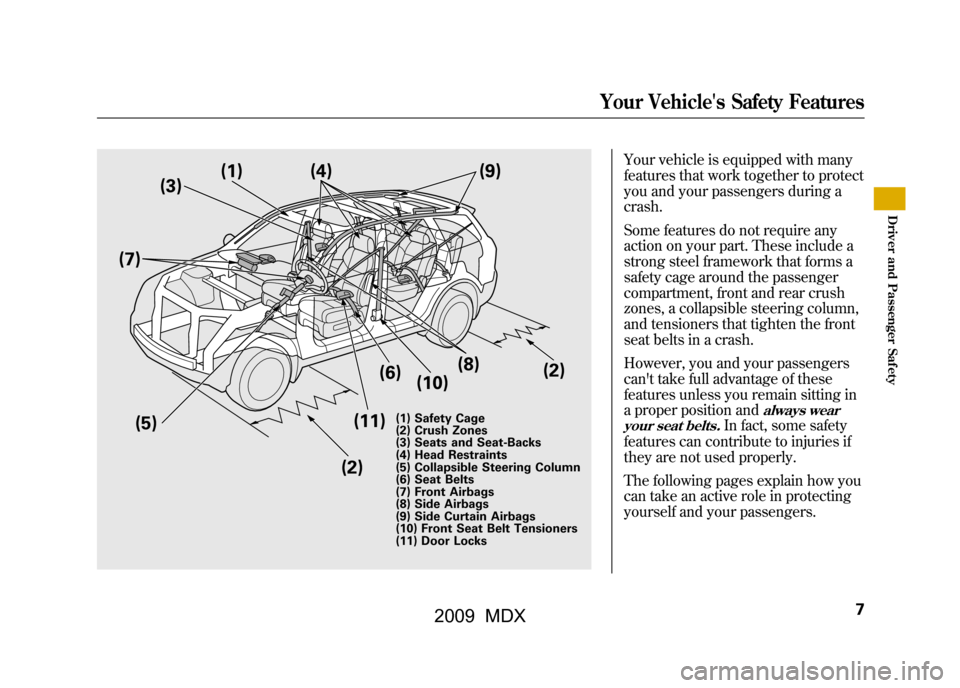
Your vehicle is equipped with many
features that work together to protect
you and your passengers during a
crash.
Some features do not require any
action on your part. These include a
strong steel framework that forms a
safety cage around the passenger
compartment, front and rear crush
zones, a collapsible steering column,
and tensioners that tighten the front
seat belts in a crash.
However, you and your passengers
can't take full advantage of these
features unless you remain sitting in
a proper position and
always wear
your seat belts.
In fact, some safety
features can contribute to injuries if
they are not used properly.
The following pages explain how you
can take an active role in protecting
yourself and your passengers.
(1) Safety Cage
(2) Crush Zones
(3) Seats and Seat-Backs
(4) Head Restraints
(5) Collapsible Steering Column
(6) Seat Belts
(7) Front Airbags
(8) Side Airbags
(9) Side Curtain Airbags
(10) Front Seat Belt Tensioners
(11) Door Locks
(1)
(3)
(7)
(5) (2)(11) (6)
(10) (8)
(2)
(9)
(4)
Your Vehicle's Safety Features
7
Driver and Passenger Saf et y
08/06/06 16:58:07 09 ACURA MDX MMC North America Owner's M 50 31STX620 enu
2009 MDX
Page 15 of 489
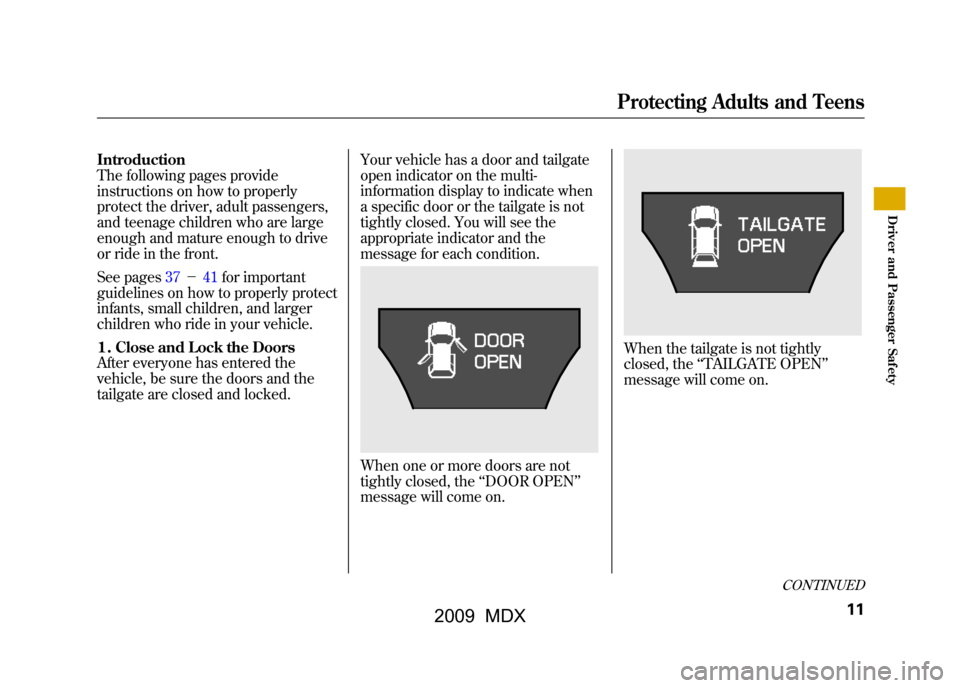
Introduction
The following pages provide
instructions on how to properly
protect the driver, adult passengers,
and teenage children who are large
enough and mature enough to drive
or ride in the front.
See pages37-41for important
guidelines on how to properly protect
infants, small children, and larger
children who ride in your vehicle.
1. Close and Lock the Doors
After everyone has entered the
vehicle, be sure the doors and the
tailgate are closed and locked. Your vehicle has a door and tailgate
open indicator on the multi-
information display to indicate when
a specific door or the tailgate is not
tightly closed. You will see the
appropriate indicator and the
message for each condition.
When one or more doors are not
tightly closed, the
‘‘DOOR OPEN’’
message will come on.
When the tailgate is not tightly
closed, the ‘‘TAILGATE OPEN ’’
message will come on.
CONTINUED
Protecting Adults and Teens
11
Driver and Passenger Saf et y
08/06/06 16:58:07 09 ACURA MDX MMC North America Owner's M 50 31STX620 enu
2009 MDX
Page 16 of 489

When both tailgate and one or more
doors are not tightly closed, the
‘‘DOOR & TAILGATE OPEN’’
message will come on. Locking the doors reduces the
chance of someone being thrown out
of the vehicle during a crash, and it
helps prevent passengers from
accidentally opening a door and
falling out.
Locking the doors also helps prevent
an outsider from unexpectedly
opening a door when you come to a
stop.
Your vehicle has the auto door
locking/unlocking feature. For more
information, see page130.
2. Adjust the Front Seats
Adjust the driver's seat as far to the
rear as possible while allowing you to
maintain full control of the vehicle.
Have a front passenger adjust their
seat as far to the rear as possible.
Protecting Adults and Teens1208/06/06 16:58:07 09 ACURA MDX MMC North America Owner's M 50 31STX620 enu
2009 MDX
Page 25 of 489
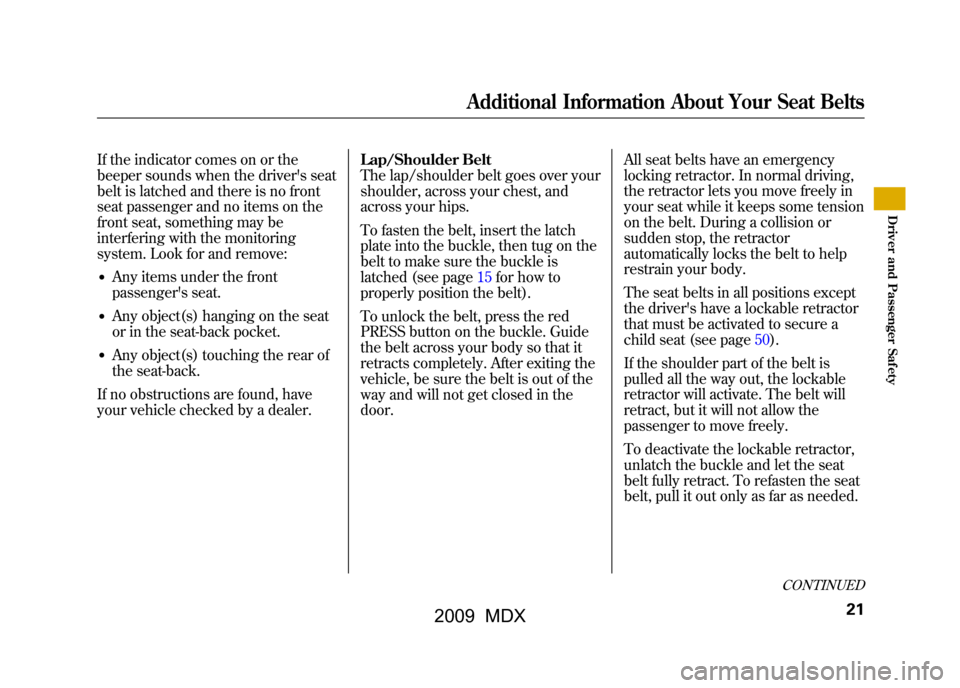
If the indicator comes on or the
beeper sounds when the driver's seat
belt is latched and there is no front
seat passenger and no items on the
front seat, something may be
interfering with the monitoring
system. Look for and remove:●Any items under the front
passenger's seat.●Any object(s) hanging on the seat
or in the seat-back pocket.●Any object(s) touching the rear of
the seat-back.
If no obstructions are found, have
your vehicle checked by a dealer. Lap/Shoulder Belt
The lap/shoulder belt goes over your
shoulder, across your chest, and
across your hips.
To fasten the belt, insert the latch
plate into the buckle, then tug on the
belt to make sure the buckle is
latched (see page15for how to
properly position the belt).
To unlock the belt, press the red
PRESS button on the buckle. Guide
the belt across your body so that it
retracts completely. After exiting the
vehicle, be sure the belt is out of the
way and will not get closed in the
door.All seat belts have an emergency
locking retractor. In normal driving,
the retractor lets you move freely in
your seat while it keeps some tension
on the belt. During a collision or
sudden stop, the retractor
automatically locks the belt to help
restrain your body.
The seat belts in all positions except
the driver's have a lockable retractor
that must be activated to secure a
child seat (see page50).
If the shoulder part of the belt is
pulled all the way out, the lockable
retractor will activate. The belt will
retract, but it will not allow the
passenger to move freely.
To deactivate the lockable retractor,
unlatch the buckle and let the seat
belt fully retract. To refasten the seat
belt, pull it out only as far as needed.
CONTINUED
Additional Information About Your Seat Belts
21
Driver and Passenger Saf et y
08/06/06 16:58:07 09 ACURA MDX MMC North America Owner's M 50 31STX620 enu
2009 MDX
Page 45 of 489
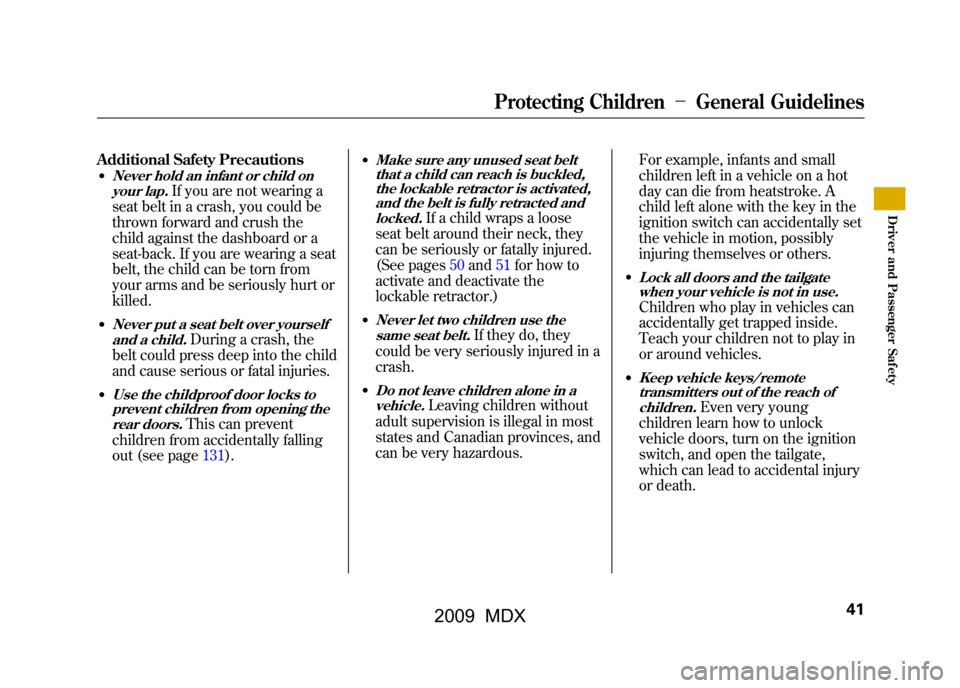
Additional Safety Precautions●Never hold an infant or child onyour lap.
If you are not wearing a
seat belt in a crash, you could be
thrown forward and crush the
child against the dashboard or a
seat-back. If you are wearing a seat
belt, the child can be torn from
your arms and be seriously hurt or
killed.
●Never put a seat belt over yourself
and a child.
During a crash, the
belt could press deep into the child
and cause serious or fatal injuries.
●Use the childproof door locks to prevent children from opening the
rear doors.
This can prevent
children from accidentally falling
out (see page131).
●Make sure any unused seat belt that a child can reach is buckled,the lockable retractor is activated,
and the belt is fully retracted and
locked.
If a child wraps a loose
seat belt around their neck, they
can be seriously or fatally injured.
(See pages50and51for how to
activate and deactivate the
lockable retractor.)
●Never let two children use the
same seat belt.
If they do, they
could be very seriously injured in a
crash.
●Do not leave children alone in a
vehicle.
Leaving children without
adult supervision is illegal in most
states and Canadian provinces, and
can be very hazardous. For example, infants and small
children left in a vehicle on a hot
day can die from heatstroke. A
child left alone with the key in the
ignition switch can accidentally set
the vehicle in motion, possibly
injuring themselves or others.
●Lock all doors and the tailgate
when your vehicle is not in use.Children who play in vehicles can
accidentally get trapped inside.
Teach your children not to play in
or around vehicles.●Keep vehicle keys/remotetransmitters out of the reach of
children.
Even very young
children learn how to unlock
vehicle doors, turn on the ignition
switch, and open the tailgate,
which can lead to accidental injury
or death.
Protecting Children -General Guidelines
41
Driver and Passenger Saf et y
08/06/06 16:58:07 09 ACURA MDX MMC North America Owner's M 50 31STX620 enu
2009 MDX
Page 46 of 489
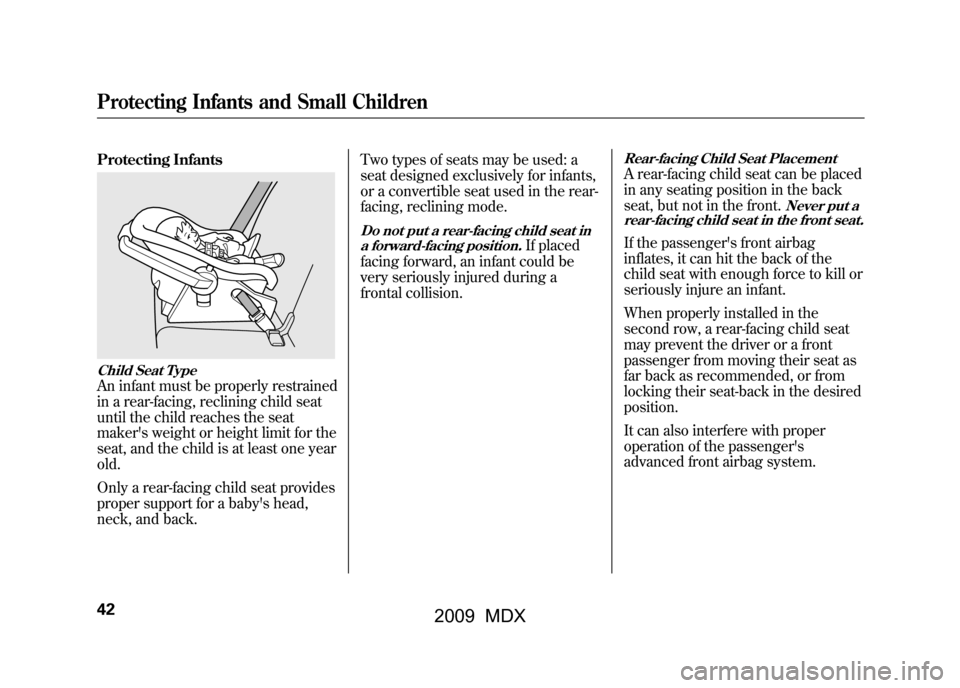
Protecting InfantsChild Seat TypeAn infant must be properly restrained
in a rear-facing, reclining child seat
until the child reaches the seat
maker's weight or height limit for the
seat, and the child is at least one year
old.
Only a rear-facing child seat provides
proper support for a baby's head,
neck, and back.Two types of seats may be used: a
seat designed exclusively for infants,
or a convertible seat used in the rear-
facing, reclining mode.
Do not put a rear-facing child seat in
a forward-facing position.
If placed
facing forward, an infant could be
very seriously injured during a
frontal collision.
Rear-facing Child Seat PlacementA rear-facing child seat can be placed
in any seating position in the back
seat, but not in the front.
Never put a
rear-facing child seat in the front seat.
If the passenger's front airbag
inflates, it can hit the back of the
child seat with enough force to kill or
seriously injure an infant.
When properly installed in the
second row, a rear-facing child seat
may prevent the driver or a front
passenger from moving their seat as
far back as recommended, or from
locking their seat-back in the desired
position.
It can also interfere with proper
operation of the passenger's
advanced front airbag system.
Protecting Infants and Small Children4208/06/06 16:58:07 09 ACURA MDX MMC North America Owner's M 50 31STX620 enu
2009 MDX
Page 54 of 489
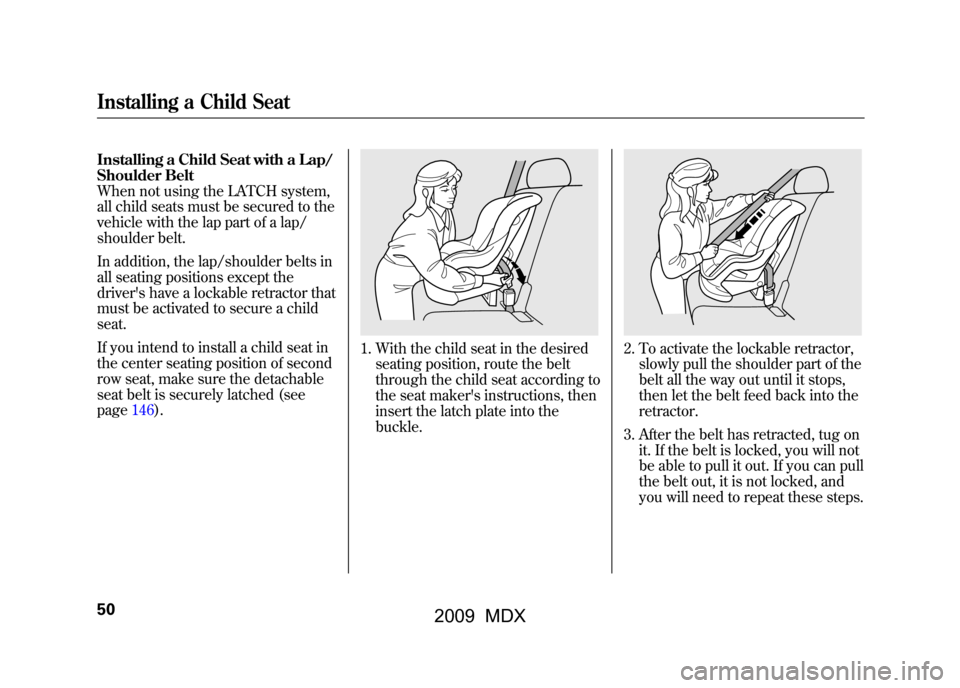
Installing a Child Seat with a Lap/
Shoulder Belt
When not using the LATCH system,
all child seats must be secured to the
vehicle with the lap part of a lap/
shoulder belt.
In addition, the lap/shoulder belts in
all seating positions except the
driver's have a lockable retractor that
must be activated to secure a child
seat.
If you intend to install a child seat in
the center seating position of second
row seat, make sure the detachable
seat belt is securely latched (see
page146).
1. With the child seat in the desiredseating position, route the belt
through the child seat according to
the seat maker's instructions, then
insert the latch plate into the
buckle.
2. To activate the lockable retractor,slowly pull the shoulder part of the
belt all the way out until it stops,
then let the belt feed back into the
retractor.
3. After the belt has retracted, tug on it. If the belt is locked, you will not
be able to pull it out. If you can pull
the belt out, it is not locked, and
you will need to repeat these steps.
Installing a Child Seat5008/06/06 16:58:07 09 ACURA MDX MMC North America Owner's M 50 31STX620 enu
2009 MDX